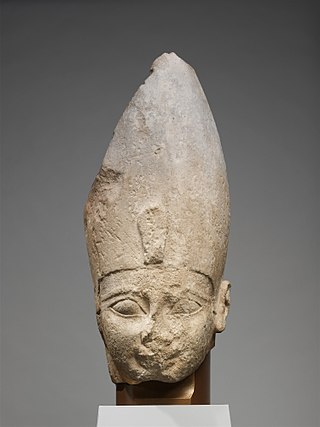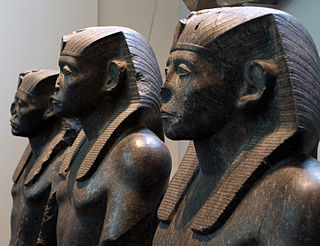
Ahmose I was a pharaoh and founder of the Eighteenth Dynasty of Egypt, classified as the first dynasty of the New Kingdom of Egypt, the era in which ancient Egypt achieved the peak of its power. He was a member of the Theban royal house, the son of pharaoh Seqenenre Tao and nephew of the last pharaoh of the Seventeenth dynasty, Kamose. During the reign of his father or grandfather, Thebes rebelled against the Hyksos, the rulers of Lower Egypt. When he was seven years old, his father was killed, and he was about ten when his brother died of unknown causes after reigning only three years. Ahmose I assumed the throne after the death of his brother, and upon coronation became known as nb-pḥtj-rꜥ "The Lord of Strength is Ra".

Merneferre Ay was an ancient Egyptian pharaoh of the mid 13th Dynasty. The longest reigning pharaoh of the 13th Dynasty, he ruled a likely fragmented Egypt for over 23 years in the early to mid 17th century BC. A pyramidion bearing his name shows that he possibly completed a pyramid, probably located in the necropolis of Memphis.

The Middle Kingdom of Egypt is the period in the history of ancient Egypt following a period of political division known as the First Intermediate Period. The Middle Kingdom lasted from approximately 2040 to 1782 BC, stretching from the reunification of Egypt under the reign of Mentuhotep II in the Eleventh Dynasty to the end of the Twelfth Dynasty. The kings of the Eleventh Dynasty ruled from Thebes and the kings of the Twelfth Dynasty ruled from el-Lisht.
The history of ancient Egypt spans the period from the early prehistoric settlements of the northern Nile valley to the Roman conquest of Egypt in 30 BC. The pharaonic period, the period in which Egypt was ruled by a pharaoh, is dated from the 32nd century BC, when Upper and Lower Egypt were unified, until the country fell under Macedonian rule in 332 BC.

Sobekneferu or Neferusobek was a pharaoh of ancient Egypt and the last ruler of the Twelfth Dynasty of the Middle Kingdom. She ascended to the throne following the death of Amenemhat IV, possibly her brother or husband, though their relationship is unproven. Instead, she asserted legitimacy through her father Amenemhat III. Her reign lasted 3 years, 10 months, and 24 days, according to the Turin King List.

Userkare Khendjer was the twenty-first pharaoh of the Thirteenth Dynasty of Egypt during the Second Intermediate Period. Khendjer possibly reigned for four to five years, archaeological attestations show that he was on the throne for at least three or four years three months and five days. Khendjer had a small pyramid built for himself in Saqqara and it is therefore likely that his capital was in Memphis.

The ancient Egyptians had an elaborate set of funerary practices that they believed were necessary to ensure their immortality after death. These rituals included mummifying the body, casting magic spells, and burials with specific grave goods thought to be needed in the afterlife.

Amenemhat I, also known as Amenemhet I, was a pharaoh of ancient Egypt and the first king of the Twelfth Dynasty of the Middle Kingdom.

Senusret I also anglicized as Sesostris I and Senwosret I, was the second pharaoh of the Twelfth Dynasty of Egypt. He ruled from 1971 BC to 1926 BC, and was one of the most powerful kings of this Dynasty. He was the son of Amenemhat I. Senusret I was known by his prenomen, Kheperkare, which means "the Ka of Re is created." He expanded Egypt that allowed him to rule over an age of prosperity.

Khakaure Senusret III was a pharaoh of Egypt. He ruled from 1878 BC to 1839 BC during a time of great power and prosperity, and was the fifth king of the Twelfth Dynasty of the Middle Kingdom. He was a great pharaoh of the Twelfth Dynasty and is considered to be, perhaps, the most powerful Egyptian ruler of the dynasty. Consequently, he is regarded as one of the sources for the legend about Sesostris. His military campaigns gave rise to an era of peace and economic prosperity that reduced the power of regional rulers and led to a revival in craftwork, trade, and urban development. Senusret III was among the few Egyptian kings who were deified and honored with a cult during their own lifetime.
Lisht or el-Lisht is an Egyptian village located south of Cairo. It is the site of Middle Kingdom royal and elite burials, including two pyramids built by Amenemhat I and Senusret I. The two main pyramids were surrounded by smaller pyramids of members of the royal family, and many mastaba tombs of high officials and their family members. They were constructed throughout the Twelfth and Thirteenth Dynasties. The site is also known for the tomb of Senebtisi, found undisturbed and from which a set of jewelry has been recovered. The pyramid complex of Senusret I is the best preserved from this period. The coffins in the tomb of Sesenebnef present the earliest versions of the Book of the Dead.

Hor Awibre was an Egyptian pharaoh of the 13th Dynasty reigning from c. 1777 BC until 1775 BC or for a few months, c. 1760 BC or c. 1732 BC, during the Second Intermediate Period. Hor is known primarily thanks to his nearly intact tomb discovered in 1894 and the rare life-size wooden statue of the king's Ka it housed.

Khasekhemre Neferhotep I was an Egyptian pharaoh of the mid Thirteenth Dynasty ruling in the second half of the 18th century BC during a time referred to as the late Middle Kingdom or early Second Intermediate Period, depending on the scholar. One of the best attested rulers of the 13th Dynasty, Neferhotep I reigned for 11 years.

The Lepsius list of pyramids is a list of sixty-seven ancient Egyptian pyramids established in 1842–1843 by Karl Richard Lepsius (1810–1884), an Egyptologist and leader of the "Prussian expedition to Egypt" from 1842 until 1846.

Sehetepibre Sewesekhtawy was an Egyptian pharaoh of the 13th Dynasty during the early Second Intermediate Period, possibly the fifth or tenth king of the Dynasty.
Nebit was an ancient Egyptian official during the reign of king Senusret III. He held the position of vizier. Thus, he was the most important official at the royal court. Nebit is only known from his large mastaba, which was excavated next to the pyramid of the king at Dahshur. The mastaba was built of mud bricks and then covered with stones. Already in ancient times the high quality stone was looted and used for other building projects or just for burning lime. However, one wall of the mastaba facade had already collapsed and had been covered by sand before looters dismantled the rest of the building. The preserved facade bears the name and title of Nebit, but also the name of the king. Within the remains of the mastaba were found by Jacques de Morgan the bust of a statue made of granodiorite. The fragment is not inscribed but most likely depicts Nebit.

The pyramid of Senusret III is an ancient Egyptian pyramid located at Dahshur and built for pharaoh Senusret III of the 12th Dynasty.

S 10 is the modern name given to a monumental ancient Egyptian tomb complex at Abydos in Egypt. The tomb is most likely royal and dates to the mid-13th Dynasty. Finds from nearby tombs indicate that S10 suffered extensive state-sanctioned stone and grave robbing during the Second Intermediate Period, only a few decades after its construction, as well as during the later Roman and Coptic periods. These finds also show that S10 was used for an actual burial and belonged to a king "Sobekhotep", now believed to be pharaoh Sobekhotep IV. According to the Egyptologist Josef W. Wegner who excavated S10, the tomb might originally have been capped by a pyramid, although Aidan Dodson states that it is still unclear whether S10 was a pyramid or a mastaba.

Mereret was an Ancient Egyptian King's Daughter known from her burial next to the Pyramid of Pharaoh Senusret III at Dahshur. On the north side of the king's pyramid was a row of four pyramids belonging to the king's wives. These pyramids were connected by an underground gallery. On the west side of the gallery were further burials arranged for women with the title king's daughter. They were buried in sarcophagi that were placed into niches. All burials were found looted. However, the robbers missed two boxes filled with personal adornments found in 1894 by Jacques de Morgan. One of these boxes must have belonged to a king's daughter Sithathor, the other box to a king's daughter with the name Mereret or Meret.
Nakht was an ancient Egyptian official living around 1950 BC under king Senusret I in the Twelfth Dynasty. His main title was high steward. As high steward he was responsible for the domains providing the palace and the royal residence with food and other resources.
















